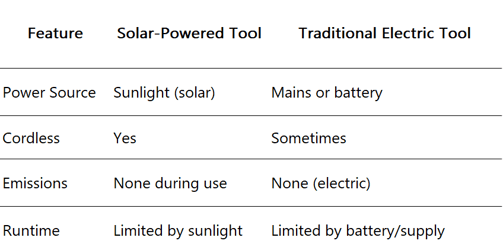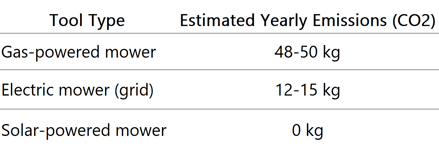Solar-Powered Garden Tools: Are They Worth the Investment for Home Gardeners?
5/8/20246 min read


Types of Solar Garden Tools Available
Several garden tool types now feature solar-powered models:
Solar Water Pumps: Used for irrigation ponds, fountains, and small-scale garden watering. Often operate autonomously during daylight.
Solar Lawn Mowers: Robotic mowers with charging stations powered by the sun. They work best in open, unobstructed spaces.
Solar Garden Lights: Used for pathway and decorative lighting. They charge during the day and provide light at night.
Solar Trimmers and Shears: Designed for light duty, these tools offer basic trimming without cords or gas.
Availability may vary depending on region and brand. Performance and features differ, so it is important to check specifications and user needs before making a purchase.
Evaluating the Investment: Costs and Savings
Solar-powered garden tools come with unique upfront costs, ongoing savings, and different upkeep requirements than traditional models. Their value depends on purchase price, expected savings on energy, and the long-term reliability of solar-powered equipment.
Initial Purchase Costs and Setup
Solar-powered garden tools usually cost more than traditional gas or corded electric models. For example, a solar lawn mower may range from $300 to $800, while a comparable corded electric mower might cost $150 to $400. The difference is often due to the integrated solar technology and lithium-ion batteries.
Some tools, such as string trimmers and leaf blowers, are available as part of “tool only” kits, requiring separate purchase of solar charging stations. Extra costs might include installation of solar panels or dock stations, which can range from $50 to $200 depending on complexity.
Table: Sample Price Comparison






A solar charger further reduces the need for electricity from the grid, especially if users live in areas with frequent sun. This means less energy drawn from fossil-fuel-powered plants.
Recyclability of Solar Tools
The materials used in solar garden tools, such as plastics, aluminum, and lithium-ion batteries, affect how recyclable these products are at end-of-life. Batteries present the biggest challenge, since improper disposal can lead to toxic chemicals leaking into the environment.
Most major brands offer recycling programs for lithium-ion batteries. The solar panels themselves can typically be recycled at specialized facilities, although the process is more efficient in regions with established solar recycling infrastructure.
Product lifespans for quality tools can be five years or more, but recycling options will ultimately depend on local facilities. It's important for users to check with local recycling centers about acceptance guidelines for e-waste and batteries to ensure proper disposal.
Although the initial investment is higher, these tools are often eligible for green or energy-efficient rebates in some regions.
Long-Term Cost Savings
Solar-powered tools operate without the need for gasoline or frequent electricity use from the grid. Charging is handled through solar energy, eliminating fuel costs and reducing electricity bills. Over a typical product lifespan of 5 to 8 years, these savings can offset the initial price difference.
Annual operating costs for solar tools are mainly related to battery replacement every 3 to 5 years, depending on use. Gas-powered alternatives require routine fuel, oil, and spark plugs. By contrast, all energy drawn from the sun is free after setup is complete.
Example: Estimated 5-Year Operating Costs
Solar mower: $60 (battery replacement)
Gas mower: $250 (fuel, oil, parts)
Electric mower: $35 (electricity)
Solar tools may offer the most savings in areas with high energy prices or where outdoor electric outlets are limited.
Maintenance Requirements and Expenses
Solar-powered tools need regular cleaning of solar panels to maintain efficiency. Dust, leaves, or pollen can block sunlight and slow charging. Lithium-ion batteries require proper storage and periodic checks, but no oiling or filter changes are needed.
Routine maintenance is generally less involved than with gas-powered tools, which require spark plug checks, oil changes, and engine cleaning. Most solar tools only require battery care and solar panel cleaning, reducing both time and cost.
Typical Maintenance Tasks
Wipe solar panels monthly to remove debris
Store batteries indoors during cold months
Inspect and replace batteries every 3-5 years
On average, annual maintenance expenses are less than $20 for solar models, compared to $40-$70 for gas-powered options. Lower maintenance demands make solar garden tools attractive to those seeking reliable, low-fuss equipment.
Performance and Practical Considerations
Solar-powered garden tools vary in performance based on their design and environmental conditions. Key issues include real-world effectiveness, area coverage, and how well they handle inconsistent sunlight.
Effectiveness Compared to Traditional Tools
Solar-powered garden tools provide quieter operation and produce no direct emissions, which benefits users in urban and suburban settings. Many models now offer reliable performance for basic tasks such as trimming, mowing small lawns, and blowing leaves. However, power output frequently falls short when compared to corded electric or gasoline-powered tools, especially under heavy or demanding conditions.
Tool runtimes usually depend on battery size and available sunlight. For example, a solar mower may run for up to 45 minutes per full charge, while gas mowers often run longer on one tank. Charging times can be lengthy if there are several cloudy days in a row.
Some users may notice a reduction in cutting or suction strength compared to traditional models. For small and medium gardens, these limitations may not matter much, but those requiring extended use or more forceful tools may find traditional options more reliable.
Suitability for Different Garden Sizes
The suitability of solar-powered garden tools depends strongly on the size and complexity of the gardening space. Small and medium gardens benefit the most, as these tools generally operate within the lower power and runtime range required. A gardener maintaining a simple yard up to around 500 square meters will likely find a solar trimmer or mower practical.
Large gardens or properties over 1,000 square meters pose challenges. Solar tools often require more frequent recharging or battery swaps to cover the area fully. Some brands address this using modular battery systems, but it means higher upfront costs and more ongoing management.
Garden layout also matters. Tools that handle narrow areas, beds, or obstacles with ease may still struggle with dense weeds or uneven terrain, impacting their effectiveness regardless of size.
Weather and Sunlight Dependence
Solar-powered tools rely on sunlight to recharge their batteries, making consistent performance difficult during cloudy or rainy periods. Extended stretches of poor weather can leave batteries depleted, delaying garden work.
In regions with high annual sunshine, users will experience more consistent readiness. Those in shaded or northern gardens may need backup charging options, such as plug-in chargers. Some brands include dual charging methods to boost flexibility, but this may reduce the environmental benefit if frequent grid charging is needed.
Monitoring sunlight exposure and planning work around the forecast becomes important with solar-powered tools. Gardeners must consider local weather patterns before choosing solar-powered equipment.
Environmental Impact and Sustainability
Solar-powered garden tools use renewable solar energy instead of fossil fuels and usually require less frequent battery replacements. Their design and materials can also influence how environmentally friendly they are throughout their lifespan.
Reducing Carbon Footprint
Using solar-powered tools significantly lowers direct greenhouse gas emissions. Traditional gas-powered garden tools emit carbon dioxide and other pollutants during operation. In contrast, solar models rely on sunlight, which produces no harmful byproducts during use.
Here's a breakdown comparing annual emissions:
Solar-Powered Garden Tools: Are They Worth the Investment for Home Gardeners?
Home gardeners are always looking for ways to make yard work easier and more sustainable. With solar-powered garden tools now widely available, many people wonder if investing in these eco-friendly devices is a smart choice. Solar-powered garden tools reduce electricity costs and reliance on fossil fuels, but their performance and practicality depend on individual needs and local climate.
These innovative tools promise quieter operation and fewer ongoing expenses compared to traditional electric or gasoline options. They also help reduce carbon footprints, which appeals to eco-conscious gardeners. Some may find them limited by charging times and lower power output, factors that can impact their overall value.
Understanding how solar-powered tools stack up against conventional options helps consumers decide if the benefits outweigh any drawbacks. Choosing the right solution means knowing the facts about cost, convenience, and capability.
Understanding Solar-Powered Garden Tools
Solar-powered garden tools use built-in solar panels to convert sunlight into energy, reducing reliance on electrical outlets or disposable batteries. These tools can help gardeners maintain their yards with less energy cost and potentially lower environmental impact.
What Are Solar-Powered Garden Tools?
Solar-powered garden tools are devices designed for outdoor yard work that operate using electricity generated directly from sunlight. They contain photovoltaic (PV) panels—usually mounted on the tool itself or connected via an external battery pack.
Most solar-powered tools are built for tasks that do not require heavy-duty power. For example, there are solar grass trimmers, hedge shears, garden lights, water pumps, and even automatic lawn mowers.
The main advantages are cordless operation and reduced fuel or battery costs. However, solar-powered tools may have limited operating times and power output, making them best suited for small to medium yards or light maintenance tasks.
How Solar Technology Works in Gardening Equipment
Solar panels on these tools absorb sunlight and convert it into DC electricity using photovoltaic cells. The electricity can either operate the tool directly or charge an onboard battery that stores energy for later use.
Energy storage is a key component. Most garden tools use lithium-ion batteries, which allow for charging during sunny periods and discharge during use, ensuring the tool operates even if clouds pass overhead.
Charging times and run times depend on solar panel size, battery capacity, and the tool’s energy needs.
Quick Comparison Table
Sustainability
Explore eco-friendly practices for a greener future.
Gardening
eyesforeco@gmail.com
© 2025. All rights reserved.
